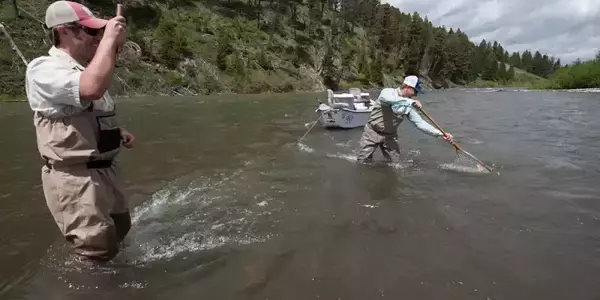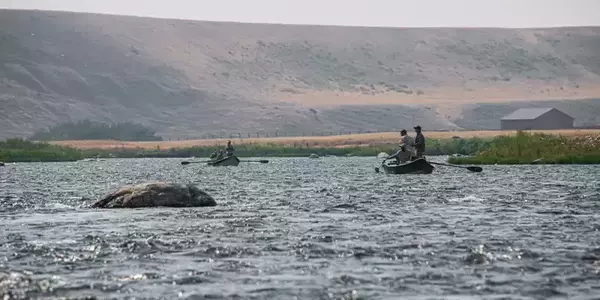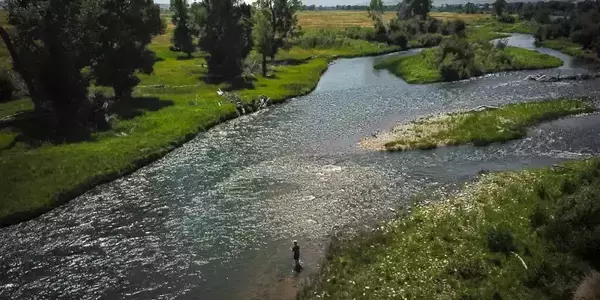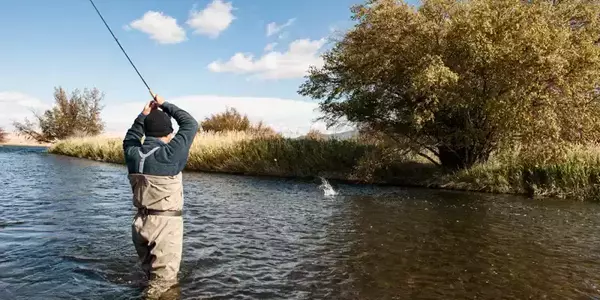
The Legendary Upper Madison River
The Madison River is perhaps the most famous and highly regarded wild trout stream in the Western US. The 50-mile stretch between Quake Lake and Ennis is known as the "50 Mile Riffle" and is referred to as the "Upper Madison River." Unlike typical western trout streams, this unique river is one long riffle dotted with boulders that break the current.
Floating the Upper Madison is a unique Montana fly fishing experience that draws anglers back year after year. Its scenery and wild trout make it a bucket list destination. Let us help customize your Montana fly fishing trip with a visit to the upper Madison River.
Fantastic float on the Madison
"...with Nick. Nick is an absolute gem. Nick is extremely knowledgeable and patient. He epitomizes the best in guides. I've floated with many and very few have his laid-back demeanor and teaching skills. He deserves a medal after several major screwups of mine as well as missed hook sets, including on what likely would have been the biggest fish of the day. Couldn't recommend Fins and Feathers and Nick more highly."
- Tom H
Sections of the Upper Madison River

Headwaters to Hebgen Lake
The confluence of the Firehole and Gibbon rivers in Yellowstone National Park forms the Madison River near Madison Junction. Here, the river slowly meanders for about 12 miles to the mouth of Hebgen Lake, near West Yellowstone, MT.
This picturesque fishery is at its prime during the early and late weeks of the YNP fishing season between Memorial Day weekend and October 31.
The river is now open year-round from the Montana/Wyoming border to the YNP park boundary.

Between the Lakes
The roughly 4 miles of river between Hebgen Dam and the inlet of Quake Lake is a legendary Montana tailwater fishery, seasonally known for holding both good numbers and trophy-sized wild trout.
The current is swift, and the wading is demanding, especially during the early summer when Hebgen Dam releases are at their peak.
This is Montana fly fishing water at its best, well-suited to skilled fly anglers who enjoy nymph and streamer fishing techniques.

Quake Lake to Lyon's Bridge
Below Quake Lake, the Madison races through a short, rugged canyon. Pocket water and boulder runs below Raynold’s Pass hold powerful rainbows and browns.
Wade fishing is preferred in this stretch and fishing while floating is prohibited by law. Many anglers use drift boats or rafts to float from one productive run to another, stopping to wade-fish areas that are less accessible to wade anglers.
Scan the banks for rising trout sipping mayflies and fish nymph rigs along the deep pockets next to myriad boulders.

Lyon's Bridge to Varney Bridge
The Madison transforms into a wide, shallow river below Lyon’s Bridge, teeming with trout. Long riffles and glides provide the perfect habitat for the wild rainbows of the Madison River.
Hoppers, ants, beetles, and attractor patterns are reliable options in late summer throughout the Madison Valley.
Hatches of blue-winged olives and midges bring rainbow and brown trout to the surface during the spring and fall.

Varney Bridge to Ennis, Montana
Below Varney Bridge, the gradient increases with fast riffles punctuated by long, slow pools and runs.
The deeper holes hold the largest brown trout in the river, often in excess of 20 inches. Precision nymphing techniques allow anglers to reach the depths where the biggest fish live.
Streamer fishing close to the bank draws explosive takes. With its big fish and technical challenges, this stretch appeals to experienced anglers, especially in the spring and fall months.

Ennis to Ennis Lake
Undercut banks, weed beds, and submerged structures provide endless lies to target the wild trout in this section of the river. The access and wadeability make this a versatile stretch to fish for both expert and novice anglers alike.
This section of the river is closed to fishing while floating, so it is ideal for the wading angler. Drift boats and rafts are used by anglers to navigate the narrow channels near Ennis Lake, but the fishing is all done from outside of the boats.
This is a particularly productive stretch of the Madison River in the spring and fall months.

April Fishing
April is a great month to experience Madison River fishing on the upper river stretches near Ennis for novice or experienced fly angler. Warming water temperatures help to increase rainbow and brown trout...

May Fishing
The upper Madison River is the last major river to be affected by the spring runoff in Southwest Montana each season. The river is rarely “unfishable,” but it can get extremely difficult and even dangerous during the peak...

July Fishing
The upper stretches of the Madison River offer some of the most prolific and rewarding fly fishing in Montana each July. This Montana river, born in Yellowstone National Park and stretching for well over 50....

August Fishing
Late summer on Montana's legendary Madison River brings exceptional dry fly fishing along with hungry trout focused on hoppers. Cool mornings offer some of the best fishing of the day during the hottest days of...

September Fishing
As autumn arrives in Montana, the Madison River continues to offer world-class fly fishing. This iconic trout stream originates in Yellowstone National Park and meanders through the heart of Southwest Montana...

Madison River Fly Fishing Guide Trips
Fins and Feathers Guide Service has been outfitting Madison River fishing trips for over two decades. We offer day trips to match your experience and interests from Raynold's Pass to Ennis Lake.
Float and wade the legendary sections near Ennis, Montana for the big browns, or focus on the dry fly waters downstream of Lyon's Bridge. The choices are endless with options for anglers of all skill levels.
Book your Madison River fishing trip with our Montana fly fishing guides online, via e-mail, or by calling us at 1-406-468-5019.

Upper Madison River Fly Fishing Photos
Perhaps the most famous of all western trout rivers, the upper Madison River is home to mile after mile of prolific trout numbers. From Ranold’s Pass to Ennis Lake, this wild and diverse fishery has been a guest favorite of ours for over two decades.
Rainbow and brown trout are the most common wild trout species that anglers encounter in these legendary river sections. Hopper fishing and the salmonfly hatch are a couple of seasonal highlights for summertime angling on the upper Madison.
Enjoy some of the sights from our guests and guides over the years in our upper Madison River fly fishing photo gallery.

Madison River Fishing Report
The upper Madison River is open year-round to fishing and offers excellent opportunities from the dead of winter through the height of summer.
Our Madison River fishing report is based on our Bozeman fly fishing guides' experiences and feedback from friends in the Montana fly fishing community on this blue-ribbon river between Raynold’s Pass and Ennis Lake.
The Fins and Feathers Montana fishing reports offer current stream flows, fishing access points, shuttle information, fishing conditions, and top fly pattern recommendations.
Related Articles From Our Montana Fly Fishing Blog

Category: Tips on Flyfishing Montana Rivers
The Best Madison River Fishing Sections
Post Date: 03/14/2024
Floating the "50 Mile Riffle" is the best way to experience the world-renowned Madison River fishing that attracts anglers from around the world. Here are our Bozeman fly fishing guides'...
Read Article
Category: Tips on Flyfishing Montana Rivers
Fly Fishing the Upper Madison River | Middle Stretches
Post Date: 09/11/2023
The middle reaches of the upper Madison River include some of the most productive drift-boat waters on the river. Montana fly fishing generally defines this piece of river as beginning...
Read Article
Category: Bozeman Fly Fishing Trip Planning
Early Season Trips for Experienced Anglers : Upper Madison River
Post Date: 09/25/2024
The Upper Madison River is a premier wild trout fishery in Montana that bursts to life as winter recedes and spring arrives. For experienced anglers, March 20th - April 1...
Read Article








